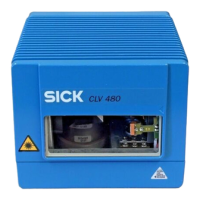Operating Instructions Chapter 3
CLV 480 Bar Code Scanner
8 010 080/O824/10-02-2005 © SICK AG · Division Auto Ident · Germany · All rights reserved 3-3
Product description
CLV with heater The following are required to start up and operate the CLV 480 with heater:
1. A SICK Connection Module from the AMV 100 or AMV 200 series to provide the power
supply and connect the data and function interfaces.
Available types:
– For connecting one CLV: AMV 100-011 (no. 6 021 105) for 24 V DC, max. IP 65
– For connecting two CLVs: AMV 200-011 (no. 6 021 106) for 24 V DC, max. IP 65
– or –
Alternatively, a non-SICK Power pack with a voltage output of 24 V DC +20 %/–10 %
to IEC
742 (functional extra-low voltage pursuant to IEC 364-4-41) and a minimum po-
wer output of 100 W.
Cable no. 2 020 264 (3 m (9.84 ft)) with 15-pin D Sub HD connector and one open
end for connecting the CLV to the non-SICK Power pack (supply voltage).
2. The following operating voltages/power output values:
– AMV 100-011: 24 V DC +20 %/–10 % (pursuant to IEC 364-4-41), min. 100 W
– AMV 200-011: 24 V DC +20 %/–10 % (pursuant to IEC 364-4-41), min. 200 W
3. See pos. 3 under CLV without heater
3.1.4 Product features and functions (overview)
High-performance laser scanner:
• Line scanner (front-end reading window)
• Scanner variant with oscillating mirror (side reading window)
• Dynamic focus
• Dynamic focus control with external or internal trigger
• Reading range 260 to 2,050 mm (10.2 to 80.7 in)
(with oscillating mirror 220 to 1,950 mm (8.7 to 76.8 in))
• Resolution 0.25 to 1.0 mm (9.8 to 39.4 mil)
(with oscillating mirror 0.3 to 1.0 mm (12 to 39.4 mil)
• Scanning/decoding frequency 600 to 1,200 Hz
• Variable active evaluation range of the scan line
Safety and user-friendly features:
• Robust, compact metal housing, max. IP 65, CE certification
• Laser class 2, laser diode switches off if reading interval is active for too long and if the
output power is exceeded
• Automatic self-test on startup. Can also be triggered at any time
• Diagnosis tools for installing and monitoring the system
• Parameterized output of reading diagnosis data in reading mode
• Operating data query, and error messages
• Test string function for signaling readiness for operation
• Future proof thanks to firmware update via serial interface (flash PROM)
• Low power consumption, other voltage range
Easy operation/configuration:
• With "CLV-Setup" PC software for Windows
• Alternatively with simple command strings, also for use with special devices

